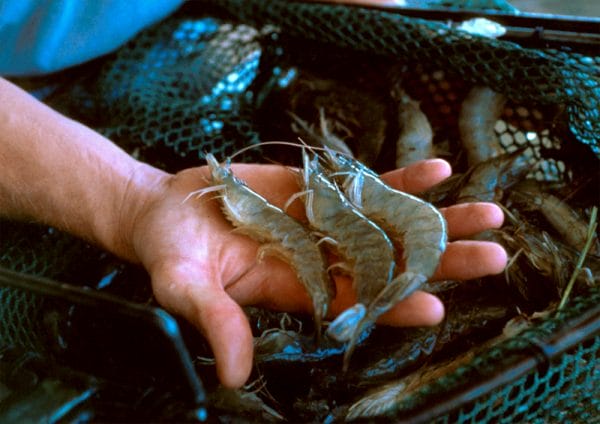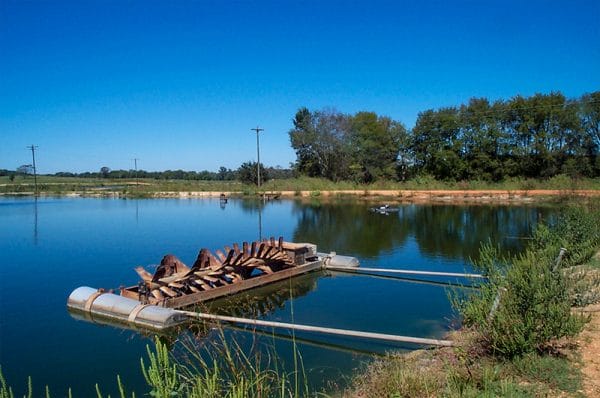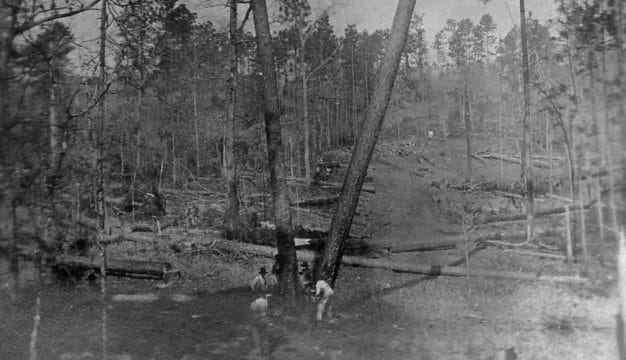Inland Shrimp Culture in Alabama
 Shrimp Harvest
The Alabama shrimp farming industry, centered in west-central Greene County, began in 1999. As of 2018, the state had four active producers with a total of 173 acres of ponds. Total production in Alabama has recently been around 305,000 pounds, with sales of live shrimp totaling more than $1 million.
Shrimp Harvest
The Alabama shrimp farming industry, centered in west-central Greene County, began in 1999. As of 2018, the state had four active producers with a total of 173 acres of ponds. Total production in Alabama has recently been around 305,000 pounds, with sales of live shrimp totaling more than $1 million.
The farming of marine or saltwater shrimp, specifically Pacific white shrimp (Litopenaeus vannamei), is a form of aquaculture, which is defined as the farming and husbandry of freshwater and marine organisms. Inland marine shrimp farming in Alabama is possible because of the presence of two deep, ancient deposits of underground saltwater known as saltwater aquifers. These aquifers, the Gordo and McShan formations, yield high concentrations of dissolved minerals, including chloride, the main constituent of seawater. This water is generally too salty for human consumption but can be used for aquaculture to grow marine shrimp, flounder, and possibly even oysters. Fish producers in Sumter and Greene County have used this water for decades in the production of farm-raised catfish. The high concentrations of chloride have a therapeutic effect on the fish. Farmers dig wells and pump the water into tanks and ponds.
Marine shrimp culture in Alabama began in 1999 in Greene County when commercial catfish farmers Rafe Taylor and Richard Odom Jr. began exploring alternative species that had a greater profit potential than catfish. Having heard about inland shrimp farming in other parts of the world such as Thailand, and with the assistance of Auburn University shrimp researchers and extension personnel, they stocked two former catfish ponds with baby shrimp. Over the summer, the mosquito-sized baby shrimp, called post-larvae, grew into commercial-grade jumbo shrimp. This particular crop averaged almost 16 shrimp to the pound. Amazed by the fact that shrimp did not need full-strength seawater right out of the ocean to grow, the men built new ponds, dug new wells, and expanded their production acreage the following year.
Their success in culturing shrimp inspired other farmers in eastern Greene, southern Tuscaloosa, and central Lowndes counties. Farmers found, however, that there were problems with culturing shrimp when farms were located more than 100 miles from the coast. Taylor’s first pond experienced a complete loss when heavy rainfall diluted the pond’s saltwater. And although Odom had good growth rates, the survival rates of the shrimp were very low. The surviving shrimp grew well but their numbers were not high enough to make the venture commercially viable.
About the same time, David Teichert-Coddington, an aquaculture specialist with the Alabama Cooperative Extension System, also began to investigate the commercial potential of inland shrimp farming. Having worked and conducted research in Honduras on commercial farms, he saw the potential in Alabama. He retired from Auburn University in 2000 and bought some land in eastern Greene County with H. Rudy Schmittou, another retired Auburn University professor. By 2000, the pair had constructed 32 acres of shrimp ponds, ranging from one to five acres, and drilled two 650-foot-deep wells. They then filled the ponds with the diluted seawater and stocked the ponds with post-larvae. Soon after stocking, however, the shrimp started to die. The surviving shrimp were extremely stressed, which indicated potential problems with the water chemistry. They knew that the same species of shrimp raised at Auburn University’s Gulf Shores Marine Laboratory did well, but the laboratory was using brackish water from the intracoastal waterway near the Gulf of Mexico.
Upon further examination, Schmittou and Teichert-Coddington found that the reasons for the low survival rates during the initial growth periods on their farm and the other farms were far more complicated than they originally thought. They compared their water chemistry with that of commercial ventures in other parts of the world and studied what little scientific literature was available. They discovered that their water lacked sufficient concentrations of potassium, magnesium, and possibly sulfur. Although they had no idea what amounts were essential, they reasoned that potassium and magnesium might be more important than sulfur.
Teichert-Coddington and Schmittou found that adding two popular land fertilizers, muriate of potash and potassium magnesium sulfate, reduced their shrimp losses overnight. The Alabama Cooperative Extension System’s Extension Aquaculturist at the Alabama Fish Farming Center in conjunction with researchers at Auburn University assisted in disseminating this important production breakthrough. Survival rates improved dramatically on Alabama’s other shrimp farms after these minerals were added to the ponds. In a subsequent study, Auburn University fisheries and aquaculture professors Allen Davis and Claude Boyd were able to determine specific amounts of the two fertilizers to add given a pond’s water chemistry. The Extension System continues to assist producers with water quality analysis and recommended treatment rates.
 Lowndes County Shrimp
Water chemistry of inland ponds varies from site to site, and commercial success depends on careful analysis of water samples. Current research is focusing on problems relating to ammonia and nitrite levels. Shrimp, unlike farmed catfish, have lower tolerances for ammonia and nitrite. As of 2007, scientists at the Alabama Cooperative Extension System were recommending that prospective shrimp producers test their water with Pacific white shrimp in aquariums before investing in ponds. Pacific white shrimp are cultured in aquariums with natural seawater, diluted seawater, and inland salty well water. The water may need to be treated with the above fertilizers. Researchers are still looking at what role minor elements in seawater play in the growth of shrimp in inland waters. This bioassay work is recommended before large amounts of money are invested in a shrimp farm.
Lowndes County Shrimp
Water chemistry of inland ponds varies from site to site, and commercial success depends on careful analysis of water samples. Current research is focusing on problems relating to ammonia and nitrite levels. Shrimp, unlike farmed catfish, have lower tolerances for ammonia and nitrite. As of 2007, scientists at the Alabama Cooperative Extension System were recommending that prospective shrimp producers test their water with Pacific white shrimp in aquariums before investing in ponds. Pacific white shrimp are cultured in aquariums with natural seawater, diluted seawater, and inland salty well water. The water may need to be treated with the above fertilizers. Researchers are still looking at what role minor elements in seawater play in the growth of shrimp in inland waters. This bioassay work is recommended before large amounts of money are invested in a shrimp farm.
The average start-up cost for a shrimp farm of between 25 and 50 acres is approximately $10,000 per acre. The major portion of this cost is pond construction. Shrimp ponds have to be designed so that the entire crop is removed when the pond is drained. The ponds must drain relatively quickly (compared with catfish ponds, which are rarely drained), and they must drain completely or large amounts of shrimp will get stranded in pockets of water out in the pond. Other capital expenses include well drilling, electrical installations for aerators, water monitoring equipment, feed bins, and coolers to hold harvested shrimp. Ponds greater than five acres present major challenges in harvesting and marketing. Shrimp have to be chilled rapidly to between 35 and 40°F after harvest to maintain quality. Large harvests can tax the available labor and resources on small farms.
The post-larvae stocked in production ponds come from nurseries in Florida, South Carolina, Texas, and South and Central America. Producers stock between 80,000 and 120,000 post-larvae shrimp per acre that range from about the size of mosquito larvae to smaller animals that are almost transparent in appearance. Ponds need to be filled with water a few weeks prior to stocking to reduce infestations of predatory insects and wild fish. Green sunfish are notorious for entering new ponds, usually getting in through the pond’s drainage structures. Certain aquatic insects such as dragonfly nymphs can also decimate newly stocked shrimp. When post-larvae shrimp grow to juvenile size, however, the nymphs become their prey. Shrimp will also prey on each other, particularly right after molting, so shrimp survival rates are rarely greater than 80 percent.
Shrimp production season generally runs from May to October. Post-larvae may be purchased as early as April, but they then must be acclimated in greenhouses or heated indoor enclosures until pond temperatures rise above 68°F. Shrimp farmers must acclimate young post- larvae for several days to a week before stocking their ponds in late May and early June. The acclimation period allows the shrimp to slowly adjust to the lower salinity of the water in Alabama compared with the hatchery water. Shrimp are fed a diet of commercial shrimp feed between one and four times a day depending on their growth rate. During the summer production season, farmers sample their stock weekly with cast nets to see if the animals are growing at the optimal rate of one and a half to two grams per week. Feeding regimes are adjusted based on these growth rates.
 Paddlewheel Aerator
Shrimp are harvested in the months of September and October before the water temperature falls to 60°F. Pacific white shrimp will die at 55°F. The ponds are drained completely, and the water is stored in an adjacent pond because environmental laws prohibit the discharge of salty water directly into the environment. The shrimp are collected in sumps on the backside of the levee or are actually pumped to a dewatering tower where the shrimp are separated from the water with a screen and collected in iced totes.
Paddlewheel Aerator
Shrimp are harvested in the months of September and October before the water temperature falls to 60°F. Pacific white shrimp will die at 55°F. The ponds are drained completely, and the water is stored in an adjacent pond because environmental laws prohibit the discharge of salty water directly into the environment. The shrimp are collected in sumps on the backside of the levee or are actually pumped to a dewatering tower where the shrimp are separated from the water with a screen and collected in iced totes.
Shrimp producers in Alabama market their shrimp in several different ways. Some sell all their shrimp directly to the public right on the farm. They advertise the dates of their harvests and people from all over the state bring their ice chests and fill them with fresh shrimp. Other producers ship their chilled shrimp to processors for de-heading, shelling, deveining, packaging and warehousing. Some sell the packaged shrimp to locally owned restaurants and supermarkets and keep some on the farm for roadside sales. Farmers have not had success in marketing their shrimp to large-scale national food wholesalers because of price competition from producers in other areas. Large wholesalers that deliver to national chain restaurants can purchase imported shrimp from Asia at a cheaper price. Alabama producers claim that their shrimp is of higher quality but price often outweighs quality among those who purchase shrimp by the thousands of pounds. As of 2015, the cost of producing Alabama inland shrimp was around $2.30 per pound. Asian shrimp can be purchased wholesale for between $2.25 and $2.45 per pound, thus leaving little margin for profit for an Alabama producer. Producers that sell shrimp on the farm can get $3.50 to $5.00 per pound, depending on the size of the shrimp.
Alabama currently lags behind other big shrimp-producing states. Texas leads the nation in production, with 2,000 acres and 6 million pounds of production. Texas is dwarfed, however, by the country of Ecuador, which raises more than 100 million pounds of shrimp annually. Despite this, the future of inland shrimp farming in Alabama looks promising. There are certainly ample resources in terms of land and water for expansion. American consumers are becoming more concerned with quality and health regarding their food choices, and Alabama shrimp are raised without the use of antibiotics and illegal chemicals often found in imported seafood. There is growing interest in organic products, and inland shrimp could be raised organically in the future. The Alabama Cooperative Extension System offers free information and advice to anyone interested in inland shrimp production.



